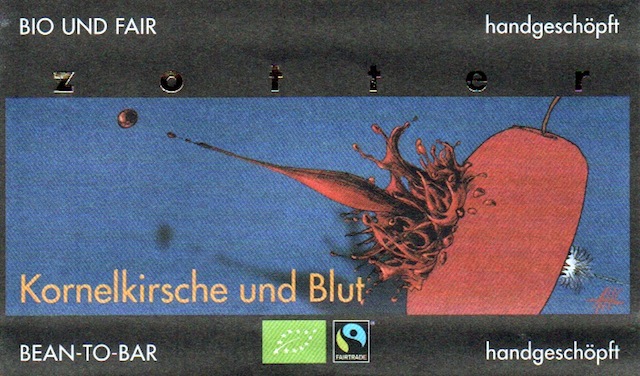
Impact
Kornelkirsche und Blut may scale the apex of Xtreme Xocolate (or nadir depending on point of view).
While flavormeisters & cocoa-gurus who lead "sophisticated" tastings fancy themselves by pairing chocolate with wine, beer, chili peppers, smoked bacon, goat cheese & the like as setting off on some bold adventure, Zotter truly dares his audience & goes for the jugular with this blood & chocolate bar. Damn vampiric of him.
To those who might've just gone into cardiac shock at the novel thought of it, blood & chocolate is nothing new.
The Mexìcâ / Aztec would embolden victims of their human sacrificial rites because it was thought of as the bleeding of the Earth & an oblation made from cacáo pods & seeds (called puyulcha, literally “sacrifice”) symbolized the human heart & blood – fluid & coursing with a life-infusing elixir. Eerily similar to the Christian Eucharist & the liturgy of that sacrifice. Indeed, during the 1500s chocolate infiltrated the Mass when Friar Toribio de Benavente (”Motolinia” or the Humble One) consecrated it the ultimate comfort food to replace wine for euphoric communicants.
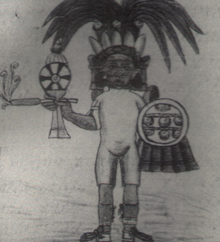 To celebrate an annual Spring rite during the festival of Toxcatl (variously meaning ‘smoke’ & ‘drought’), Mexìcâ / Aztec priests would select a young man, idealized for both his physical beauty & artistic talent, to ixiptlatli or impersonate the powerful deity Texcatlipoca (‘Smoking Mirror’) in a show of veneration. This Meso-American Idol then rock starred for a whole year, receiving honors everywhere, including maiden groupies. Toward the end of his term, he’d be plied with cups of chocolate mixed with achiote, symbolizing again heart & blood, to ready him for the encore. Instead of a Cinderella story turning back into a pumpkin, he was literally toast… sacrificed at the edge of an obsidian blade (reflective of mirror), heart severed & burned in the temple’s brazier. Blood, & by extension the still-beating heart, renewed a connection with the sacred that seemed essential to the very existence of their natural order. Rubbing it on idols (in this case Texcatlipoca) ensouled them to operate in a literal transubstantiation, rather than a symbolic transformation, on which the fate of the world & its inhabitants depended. Priests then flay the rest of the body for consumption.
To celebrate an annual Spring rite during the festival of Toxcatl (variously meaning ‘smoke’ & ‘drought’), Mexìcâ / Aztec priests would select a young man, idealized for both his physical beauty & artistic talent, to ixiptlatli or impersonate the powerful deity Texcatlipoca (‘Smoking Mirror’) in a show of veneration. This Meso-American Idol then rock starred for a whole year, receiving honors everywhere, including maiden groupies. Toward the end of his term, he’d be plied with cups of chocolate mixed with achiote, symbolizing again heart & blood, to ready him for the encore. Instead of a Cinderella story turning back into a pumpkin, he was literally toast… sacrificed at the edge of an obsidian blade (reflective of mirror), heart severed & burned in the temple’s brazier. Blood, & by extension the still-beating heart, renewed a connection with the sacred that seemed essential to the very existence of their natural order. Rubbing it on idols (in this case Texcatlipoca) ensouled them to operate in a literal transubstantiation, rather than a symbolic transformation, on which the fate of the world & its inhabitants depended. Priests then flay the rest of the body for consumption.
That blood courses throughout Mexìcâ / Aztec mythology owes much to having been borrowed from prior traditions as a stratagem to legitimize their rule.
For instance, in the K’iche’ Mayan epic Popul Vuh, after the first people were created, they gathered at Tollan, a mythical Place of 7 Caves, to receive their language & gods. There the K’iche’ accepted a Holy Trinity (Awilix, Jacawitz and Tohil). Tohil (aka God K; forerunner to the Aztec’s Quetzalcoatl) then demanded blood sacrifice of them, likening blood consumption to the suckling of an infant by its mother. So the K’iche’ offered their own as well as that of POWs captured in battle. That fulfilled the covenant just as the blood of Christ’s crucifixion formed a ‘New Covenant’ for Christians. Both archaic acts should be viewed within this framework.
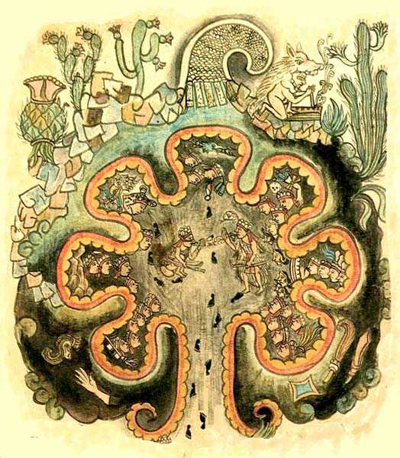
The 7 Caves from where the Mexìcâ / Aztecs claim their origins
Unless the gods, having sacrificed themselves to create the world, could be propitiated with a fungible payment-in-kind via sacrificial rites or offered the sacred substance of precious blood that could breakthrough the celestial barriers, the solar orb would extinguish -- a critical fact as Sophie Coe writes, that formed their raison d’être of self-sacrifice – not blood lust, cruelty, nor a death wish per se, even granting that the Mexìcâ (Aztecs) were a highly militaristic-warrior society in which upward mobility occurred only thru aggressive warfare but “a fear lest the world & the life on it should perish”… so they kindled fire to keep it going. No excuse, just an explanation.
Admittedly, the gods must’ve been terribly thirsty for blood.
For in the year 1487 AD, possibly the height of bloodletting occurred at Tenochtitlán, the capital of the Mexìcâ. The dedication for the 6th temple expansion -- the very "heart" of the Empire -- witnessed a procession of 20,000 or more bleeding souls, ordered by Tlatoani (’great one who speaks’) Ahuizotl (the emperor) marched up the towering pyramid rising from the valley & silhouetted by the mountains beyond, its steep balustrades flanked with menacing serpents to the grand platform, atop which ‘priests plunged obsidian knives decorated with eyes & teeth called “face blades” into prone victims, ripped them out to slit their throats, then reached back in to sever still-beating hearts that would be retrieved & held aloft, offered up in the braziers burning the sacred fire as if with so much hot chili sauce’. By the end, a river of blood ran down the steps to bathe the plaza below thicker than a slaughter-house floor. For war captives the ordeal went further: decapitated, then limbs chopped off &, finally, body parts cast from the temple chambers to lie, perhaps, on the Coyolxauhqui stone — the daughter of Earth mother Coatlicue – herself dismembered by her brother, the war-god Huitzilpochtli.
Years later during the Toxcatl festival month of 1520 when Spanish-American relations turned for the worse, Spaniards under Gen. Cortés brought a halt to human sacrifice... after first, of course, annihilating their Mexìcâ foes in battle. He supposedly ordered the Tlatoani Motecuhzoma to scrub the blood-stained steps of the temple.
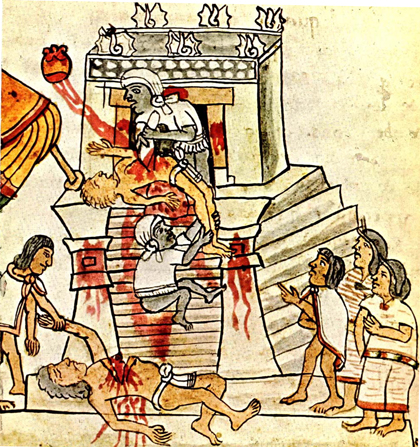
Human or inhumane sacrifice? Suffering a massive heart attack on the temple’s throbbing steps of doom. (From the Codex Magliabechian, 16th century)
Even today among the Lacandón Maya of Chiapas Mexico the association of blood & chocolate endures. Their 'God Pots' for incense &/or offerings are small ceramic bowls usually adorned with the full-featured head of the deity they represent attached to the rim. Pots come "alive" during ritual use, ensouled (pixan) with the essence from incense smoke, centered by placing sacred stones from Maya ruins, & given heart with cacáo seeds. The ancient practice of reddening with achiote so the whole admixture cumulatively presents a form of “burning blood” symbolizes sacrifice that the gods “consume” for nourishment in order to maintain balance in the universe.
Enough background, let Zotter take it from here:
He forgot to mention it helps cure amenorrhea (that medical condition in which a non-pregnant woman keeps missing her menstrual period) in keeping with cacáo's ancient associations with female sexuality & fertility. But that's a whole other story / dissertation.
In the meanwhile, those squeamish about blood can always resort to those "sophisticated" hook-ups listed above.
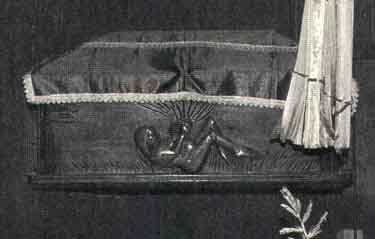
Pregnant mother carved on a sacred chest containing cacáo seeds (Santiago Atitlan, Guatemala; courtesy of Cameron McNeil)
While flavormeisters & cocoa-gurus who lead "sophisticated" tastings fancy themselves by pairing chocolate with wine, beer, chili peppers, smoked bacon, goat cheese & the like as setting off on some bold adventure, Zotter truly dares his audience & goes for the jugular with this blood & chocolate bar. Damn vampiric of him.
To those who might've just gone into cardiac shock at the novel thought of it, blood & chocolate is nothing new.
The Mexìcâ / Aztec would embolden victims of their human sacrificial rites because it was thought of as the bleeding of the Earth & an oblation made from cacáo pods & seeds (called puyulcha, literally “sacrifice”) symbolized the human heart & blood – fluid & coursing with a life-infusing elixir. Eerily similar to the Christian Eucharist & the liturgy of that sacrifice. Indeed, during the 1500s chocolate infiltrated the Mass when Friar Toribio de Benavente (”Motolinia” or the Humble One) consecrated it the ultimate comfort food to replace wine for euphoric communicants.
 To celebrate an annual Spring rite during the festival of Toxcatl (variously meaning ‘smoke’ & ‘drought’), Mexìcâ / Aztec priests would select a young man, idealized for both his physical beauty & artistic talent, to ixiptlatli or impersonate the powerful deity Texcatlipoca (‘Smoking Mirror’) in a show of veneration. This Meso-American Idol then rock starred for a whole year, receiving honors everywhere, including maiden groupies. Toward the end of his term, he’d be plied with cups of chocolate mixed with achiote, symbolizing again heart & blood, to ready him for the encore. Instead of a Cinderella story turning back into a pumpkin, he was literally toast… sacrificed at the edge of an obsidian blade (reflective of mirror), heart severed & burned in the temple’s brazier. Blood, & by extension the still-beating heart, renewed a connection with the sacred that seemed essential to the very existence of their natural order. Rubbing it on idols (in this case Texcatlipoca) ensouled them to operate in a literal transubstantiation, rather than a symbolic transformation, on which the fate of the world & its inhabitants depended. Priests then flay the rest of the body for consumption.
To celebrate an annual Spring rite during the festival of Toxcatl (variously meaning ‘smoke’ & ‘drought’), Mexìcâ / Aztec priests would select a young man, idealized for both his physical beauty & artistic talent, to ixiptlatli or impersonate the powerful deity Texcatlipoca (‘Smoking Mirror’) in a show of veneration. This Meso-American Idol then rock starred for a whole year, receiving honors everywhere, including maiden groupies. Toward the end of his term, he’d be plied with cups of chocolate mixed with achiote, symbolizing again heart & blood, to ready him for the encore. Instead of a Cinderella story turning back into a pumpkin, he was literally toast… sacrificed at the edge of an obsidian blade (reflective of mirror), heart severed & burned in the temple’s brazier. Blood, & by extension the still-beating heart, renewed a connection with the sacred that seemed essential to the very existence of their natural order. Rubbing it on idols (in this case Texcatlipoca) ensouled them to operate in a literal transubstantiation, rather than a symbolic transformation, on which the fate of the world & its inhabitants depended. Priests then flay the rest of the body for consumption.That blood courses throughout Mexìcâ / Aztec mythology owes much to having been borrowed from prior traditions as a stratagem to legitimize their rule.
For instance, in the K’iche’ Mayan epic Popul Vuh, after the first people were created, they gathered at Tollan, a mythical Place of 7 Caves, to receive their language & gods. There the K’iche’ accepted a Holy Trinity (Awilix, Jacawitz and Tohil). Tohil (aka God K; forerunner to the Aztec’s Quetzalcoatl) then demanded blood sacrifice of them, likening blood consumption to the suckling of an infant by its mother. So the K’iche’ offered their own as well as that of POWs captured in battle. That fulfilled the covenant just as the blood of Christ’s crucifixion formed a ‘New Covenant’ for Christians. Both archaic acts should be viewed within this framework.

Unless the gods, having sacrificed themselves to create the world, could be propitiated with a fungible payment-in-kind via sacrificial rites or offered the sacred substance of precious blood that could breakthrough the celestial barriers, the solar orb would extinguish -- a critical fact as Sophie Coe writes, that formed their raison d’être of self-sacrifice – not blood lust, cruelty, nor a death wish per se, even granting that the Mexìcâ (Aztecs) were a highly militaristic-warrior society in which upward mobility occurred only thru aggressive warfare but “a fear lest the world & the life on it should perish”… so they kindled fire to keep it going. No excuse, just an explanation.
Admittedly, the gods must’ve been terribly thirsty for blood.
For in the year 1487 AD, possibly the height of bloodletting occurred at Tenochtitlán, the capital of the Mexìcâ. The dedication for the 6th temple expansion -- the very "heart" of the Empire -- witnessed a procession of 20,000 or more bleeding souls, ordered by Tlatoani (’great one who speaks’) Ahuizotl (the emperor) marched up the towering pyramid rising from the valley & silhouetted by the mountains beyond, its steep balustrades flanked with menacing serpents to the grand platform, atop which ‘priests plunged obsidian knives decorated with eyes & teeth called “face blades” into prone victims, ripped them out to slit their throats, then reached back in to sever still-beating hearts that would be retrieved & held aloft, offered up in the braziers burning the sacred fire as if with so much hot chili sauce’. By the end, a river of blood ran down the steps to bathe the plaza below thicker than a slaughter-house floor. For war captives the ordeal went further: decapitated, then limbs chopped off &, finally, body parts cast from the temple chambers to lie, perhaps, on the Coyolxauhqui stone — the daughter of Earth mother Coatlicue – herself dismembered by her brother, the war-god Huitzilpochtli.
Years later during the Toxcatl festival month of 1520 when Spanish-American relations turned for the worse, Spaniards under Gen. Cortés brought a halt to human sacrifice... after first, of course, annihilating their Mexìcâ foes in battle. He supposedly ordered the Tlatoani Motecuhzoma to scrub the blood-stained steps of the temple.

Even today among the Lacandón Maya of Chiapas Mexico the association of blood & chocolate endures. Their 'God Pots' for incense &/or offerings are small ceramic bowls usually adorned with the full-featured head of the deity they represent attached to the rim. Pots come "alive" during ritual use, ensouled (pixan) with the essence from incense smoke, centered by placing sacred stones from Maya ruins, & given heart with cacáo seeds. The ancient practice of reddening with achiote so the whole admixture cumulatively presents a form of “burning blood” symbolizes sacrifice that the gods “consume” for nourishment in order to maintain balance in the universe.
Enough background, let Zotter take it from here:
This scandalous chocolate does away with prejudices: Blood is a high-quality food which contains plenty of iron & proteins. Lightly pasteurised pig’s blood renders the milk ganache extremely creamy & valuable. Merely the thyme is noticeable in the taste. Rounded off by the matching Cornelian cherry jelly which is not poisonous but an old remedy with high vitamin C content.
He forgot to mention it helps cure amenorrhea (that medical condition in which a non-pregnant woman keeps missing her menstrual period) in keeping with cacáo's ancient associations with female sexuality & fertility. But that's a whole other story / dissertation.
In the meanwhile, those squeamish about blood can always resort to those "sophisticated" hook-ups listed above.

Appearance 4.6 / 5
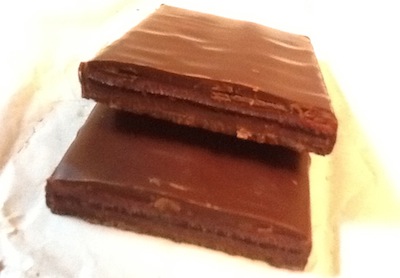

| Color: | quite ferric... call it 'hemoglobin brown' (gorgeous really; almost ruby) |
| Surface: | unblemished |
| Temper: | anamorphic |
| Snap: | crepitates |
Aroma 7.4 / 10
a veggie burger, strangely enough, of sorts: sunflower seeds, beet root juice, onion rings & pepper doused with bar-b-q sauce (seriously)
Mouthfeel 11.8 / 15
| Texture: | smooth save for a stray cherry skin |
| Melt: | fast from mid-length onward... dissolves around that skin |
Flavor 30.6 / 50
quik chocolate over the faint oxide (reflected in this bar's color) & just as quickly sour cherry + apple cider take over, the pair blending into cranberry -> iron compound steels the senses as blood makes its entrance, pretty strong 'n long on the tongue from whence the melt accelerates -> cocoa tannins re-assert some presence but the blood squashes them with an iron-fist
Quality 13.3 / 20
Oh, those profligate sophisticrats who try to impress their guests by butchering the whole pig for its meat when just a few swigs of blood would suffice.
By no stretch a bloody mess, this is quite measured.
Obviously non-Kosher & non-Halel but Christians & cannibals (like Anthony Bourdain whose name falls close to the French pork blood dish called boudin) & others feeling likewise savage will appreciate the strength of blood drawn in this bar's length. Though barely 1% of total volume, it cuts thru with a visceral thrill.
Zotter mercifully pairs the blood with Cornelian Cherries, both for their complementary color that psychologically heighten the FXs & counter if not mask the iron weight with their tart zing. Nevertheless, for the uninitiated it will provoke at the very least some low-intensity winces & grimaces just at the thought as well as the taste of it.
Overall, Kornelkirsche und Blut harmonizes better than Zotter's other crazy bar (Trout Fish) even as it parodies in a confected way the punishing treatment on the palate of some super hi-percentage chocolate or even unsweetened bars.
An audacious conversation piece rather than any true gastronomic union.
INGREDIENTS: raw canne sugar, cocoa mass, cocoa butter, cornelian cherry puree, fructose-glucose syrup, milk, almonds, red beet powder, butter, lemon concentrate, blood, apple balsam vinegar, apple pectin, salt, lecithin, caraway, thyme oil
Reviewed July 12, 2012
By no stretch a bloody mess, this is quite measured.
Obviously non-Kosher & non-Halel but Christians & cannibals (like Anthony Bourdain whose name falls close to the French pork blood dish called boudin) & others feeling likewise savage will appreciate the strength of blood drawn in this bar's length. Though barely 1% of total volume, it cuts thru with a visceral thrill.
Zotter mercifully pairs the blood with Cornelian Cherries, both for their complementary color that psychologically heighten the FXs & counter if not mask the iron weight with their tart zing. Nevertheless, for the uninitiated it will provoke at the very least some low-intensity winces & grimaces just at the thought as well as the taste of it.
Overall, Kornelkirsche und Blut harmonizes better than Zotter's other crazy bar (Trout Fish) even as it parodies in a confected way the punishing treatment on the palate of some super hi-percentage chocolate or even unsweetened bars.
An audacious conversation piece rather than any true gastronomic union.
INGREDIENTS: raw canne sugar, cocoa mass, cocoa butter, cornelian cherry puree, fructose-glucose syrup, milk, almonds, red beet powder, butter, lemon concentrate, blood, apple balsam vinegar, apple pectin, salt, lecithin, caraway, thyme oil
Reviewed July 12, 2012




